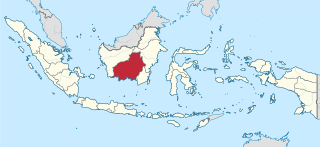
Central Kalimantan is a province of Indonesia. It is one of five provinces in Kalimantan, the Indonesian part of Borneo. It is bordered by West Kalimantan to the west, South Kalimantan and East Kalimantan to the east, Java Sea to the south and is separated narrowly from North Kalimantan and Malaysia by East Kalimantan's Mahakam Ulu Regency. Its provincial capital is Palangka Raya and in 2010 its population was over 2.2 million, while the 2020 Census showed a total of almost 2.67 million; the official estimate as at mid 2023 was 2,774,747.

South Sumatra is a province of Indonesia, located in the southeast of the island of Sumatra. The capital and largest city of the province is the city of Palembang. The province borders the provinces of Jambi to the north, Bengkulu to the west and Lampung to the south, as well a maritime border with the Bangka Belitung Islands to the east. It is the largest province in the island of Sumatra, and it is slightly smaller than Portugal. The Bangka Strait in the east separates South Sumatra and the island of Bangka, which is part of the Bangka Belitung Islands province. The province has an area of 91,592.43 km2 (35,364 sq mi) and had a population of 8,467,432 at the 2020 Census; the official estimate as at mid-2023 was 8,743,522. The province is rich in natural resources, such as petroleum, natural gas and coal. The province is inhabited by many different malay sub ethnic groups, with Palembangese being largest ethnic group. Most speak the Palembang language, which is mutually intelligible to both Indonesian and local Palembang Malay. Other ethnic groups include the Javanese, Sundanese, Minangkabau and Chinese. Most are concentrated in urban areas and are largely immigrants from other parts of Indonesia.

Balinese dance is an ancient dance tradition that is part of the religious and artistic expression among the Balinese people of Bali island, Indonesia. Balinese dance is dynamic, angular, and intensely expressive. Balinese dancers express the stories of dance-drama through bodily gestures including gestures of fingers, hands, head, and eyes.

The Bantenese are an indigenous ethnic group native to Banten in the westernmost part of Java island, Indonesia. The area of Banten province corresponds more or less with the area of the former Banten Sultanate, a Bantenese nation state that preceded Indonesia. In his book "The Sultanate of Banten", Guillot Claude writes on page 35: “These estates, owned by the Bantenese of Chinese descent, were concentrated around the village of Kelapadua.” Most of Bantenese are Sunni Muslim. The Bantenese speak the Sundanese-Banten dialect, a variety of the Sundanese language which does not have a general linguistic register, this language is called Basa Sunda Banten.

Tapis is a traditional Tenun style and also refers to resulting cloth that originated from Lampung, Indonesia. It consists of a striped, naturally-coloured cloth embroidered with warped and couched gold thread. Traditionally using floral motifs, it has numerous variations. It is generally worn ceremonially, although it can be used as a decoration. It is considered one of the symbols of Lampung and Lampungese.
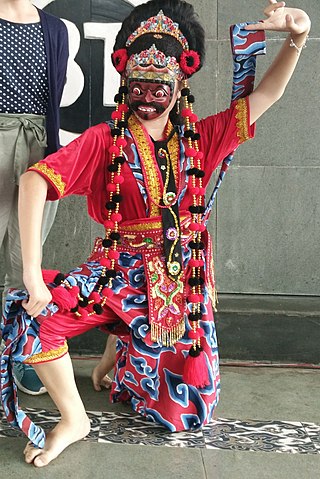
Cirebonese mask dance is a local indigenous art form of Cirebon in Java, including Indramayu and Jatibarang, West Java and Brebes, Central Java. It is called mask dance because the dancers use masks when dancing. There is a lot of variety in Javanese mask dance, both in terms of the dance style and the stories to be conveyed. This mask dance can be performed by solo dancers, or performed by several people.

The national costume of Indonesia is the national attire that represents the Republic of Indonesia. It is derived from Indonesian culture and Indonesian traditional textile traditions. Today the most widely recognized Indonesian national attires include batik and kebaya, although originally those attires mainly belong within the island of Java and Bali, most prominently within Javanese, Sundanese and Balinese culture. Since Java has been the political and population center of Indonesia, folk attire from the island has become elevated into national status.

Piring dance is a traditional Minangkabau plate dance originated and performed in West Sumatra, Indonesia. It is also performed in Negeri Sembilan, Malaysia. The dance might be performed by a group of women, men, or couples; each of whom holds a plate in each hand, and vigorously rotates or half rotates them in various formations and fast movements.
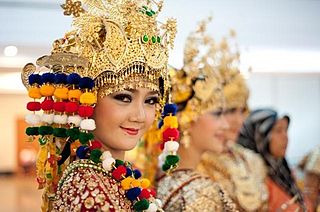
Gending Sriwijaya is the name of the traditional performance whether it is a song, music, as well as dance that originated from Palembang, South Sumatra, Indonesia. Both of the song and the dance was created to describes the splendor, cultural refinement, glory and the grandeur of Srivijaya empire that once succeed on unifying the western parts of Indonesian archipelago and Malay world generally.
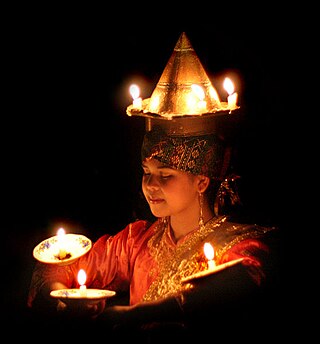
The candle dance is an Indonesian dance performed by a group of dancers to the accompaniment of a group of musicians. The dancers carry lit candles on plates held on the palm of each hand. The dancers dance in groups, rotating the plates carefully so that the plate is always horizontal, and the candles are not extinguished. The dance is said to have originated in Sumatra, Indonesia.
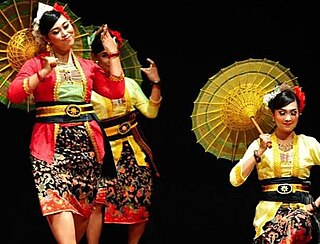
Payung dance is a folk dance-drama tradition of the Minangkabau-Malay ethnic group in Sumatra, Indonesia. This dance is a Minangkabau version of other Malay dances from Sumatra. Folk theatre such as toneel and sandiwara often incorporates payung dance as part of the show. The payung (umbrella) is the main prop used in this dance, and the dance itself, which is usually performed by three or four dancers, symbolizes affection and the relationship of young people. The dance originates from Western Sumatra, Indonesia.

In Indonesia, a fire performance is a group of performance arts or skills that involve the manipulation of fire. It includes using fire as a finale in an otherwise non-fire performance. Performances can be done as choreographed routines to music.
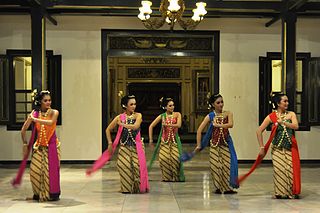
Gambyong is a traditional Javanese dance originating from Surakarta, Central Java, Indonesia. It has existed since ancient times, and began to be displayed at the Mangkunegaran Palace in the era of 1916 to 1944. Gambyong became famous for its smooth and graceful dance moves that amazed the audience who watch them.
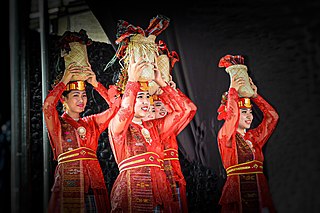
Tandok dance is a traditional Batak dance originating from the North Sumatra, Indonesia. This dance tells about the activities of harvesting rice using tandok carried out by mothers in the fields. In addition, this dance also contains the importance of family values between each other.

Lengger is a traditional Javanese dance originating from Banyumas, Central Java, Indonesia. This dance is played in pairs, between a man and a woman. Lengger dance is one of the sacred dances in Java.

Lenger lanang is a traditional Javanese dance originating from Banyumas, Central Java, Indonesia. This dance has existed for hundreds of years. Lengger lanang is not just an ordinary dance but a tradition of worshiping the Goddess of Fertility to celebrate harvests or village clean ceremonies that have been passed down from generation to generation. Lengger lanang dance is a form of cross-gender culture in Indonesia. This dance is categorized as cross-gender because the performer is a man who appears to be a woman.

Tortor is a traditional Batak dance originating from North Sumatra, Indonesia. This dance was originally a ritual and sacred dance performed at funerals, healing ceremonies, and other traditional Batak ceremonies. For the Batak people, tortor dance has both cultural and spiritual values. Through this dance, people express their hopes and prayers. Demonstrations of attitudes and feelings through this dance describe the situation and conditions that are being experienced.

Yapong dance is a Betawi dance originating in Jakarta, Indonesia. This dance depicts the association of young people created by the artist Bagong Kussudiardja. The Yapong dance was performed for the first time to enliven Jakarta's 450th anniversary event in 1977.

Kebagh dance, formerly known as the Semban Bidodari, is a traditional Palembang dance originating in Pagaralam, South Sumatra, Indonesia. This dance is characterized by the movement of opening both hands, such as spreading wings, and is usually performed to welcome distinguished guests in traditional ceremonies.
Cinta Sayang is a traditional Malay dance originated from the state of Kedah in northern Peninsular Malaysia. The dance is popular amongst Kedah Malays as an opening dance for important events.




























